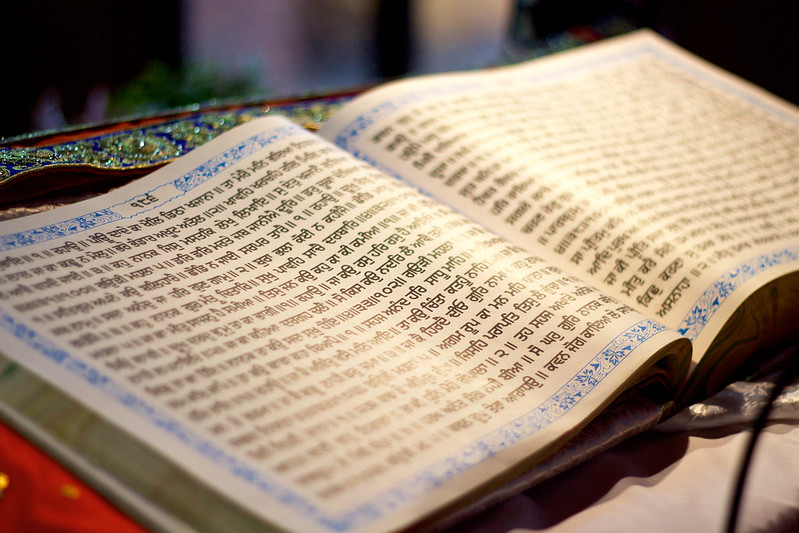zoomacademia.com – The Guru Granth Sahib is the central religious scripture of Sikhism and is revered by Sikhs as their eternal Guru. Unlike other religious texts that are considered the inspired words of a human prophet or messenger, the Guru Granth Sahib is unique in that it is considered not just a book but the living and divine Guru itself. It is a compilation of hymns, prayers, and writings from a diverse group of spiritual leaders, including Sikh Gurus, Hindu saints, Muslim mystics, and other religious thinkers, making it a symbol of interfaith harmony and universality.
Historical Background
The Guru Granth Sahib was first compiled during the lifetime of the tenth Sikh Guru, Guru Gobind Singh. Guru Gobind Singh, the last of the ten human Gurus, declared the Guru Granth Sahib to be the eternal Guru of the Sikh community before his death in 1708. He instructed his followers to no longer seek a human Guru, as the Guru Granth Sahib would serve as the guide for Sikhs in all matters of spiritual and worldly life. The formal installation of the Guru Granth Sahib as the Guru occurred at the Harmandir Sahib (Golden Temple) in Amritsar, which remains the holiest site in Sikhism.
The Composition of the Guru Granth Sahib
The Guru Granth Sahib consists of 1,430 pages (known as Angs), with a total of 5,894 hymns. These hymns are written in Gurmukhi script and are set to a variety of musical compositions, called ragas, which aid in the meditative experience. The scripture is divided into 32 ragas, each with a specific mood, and the hymns are intended to be sung as devotional songs, reflecting the deep spiritual and emotional connection between the devotee and God.
The content of the Guru Granth Sahib is written in several languages, including Punjabi, Sanskrit, Hindi, Persian, and Brahmi, reflecting the cultural diversity of the time. The scripture was compiled over the course of several centuries, with contributions from Guru Nanak (the first Guru) to Guru Arjan (the fifth Guru), and Guru Gobind Singh, who included the writings of other prominent saints and scholars like Bulleh Shah, Kabir, Namdev, and Farid.
Key Teachings and Themes
The teachings of the Guru Granth Sahib emphasize oneness of God, truth, selfless service, and equality of all people, transcending the boundaries of caste, creed, and religion. Some of the core principles conveyed in the text include:
- Oneness of God (Ik Onkar): The Guru Granth Sahib begins with the sacred phrase “Ik Onkar”, meaning “There is one God”. This fundamental teaching asserts that God is formless, eternal, and omnipresent, transcending all human concepts of time, space, and form. God is described as being both immanent and transcendent, present within all creation but beyond human comprehension.
- The Importance of Meditation and Devotion: The text emphasizes the need for Naam Simran (remembrance of God’s name) as a way to connect with the divine. Sikhs believe that by meditating on God’s name (Waheguru), one can overcome the distractions and desires of the ego, leading to spiritual liberation (Mukti).
- Equality of All People: The Guru Granth Sahib advocates for the equality of all human beings, regardless of their social status, caste, gender, or religion. It strongly opposes discrimination, particularly the rigid caste system that existed in Indian society at the time. Sikhs are taught to view all people as equal in the eyes of God.
- Selfless Service (Seva): The concept of Seva (selfless service) is central to Sikh spirituality. Sikhs are encouraged to serve others, especially the underprivileged and marginalized, as a way to express their devotion to God. The Guru Granth Sahib teaches that true devotion to God is not limited to rituals but is reflected in selfless action in the world.
- Living a Just and Honest Life: The text emphasizes the need for Sikhs to lead an honest life, earn their livelihood through hard work (Kirat Karni), and share with others through charitable acts (Vand Chakna). The Guru Granth Sahib condemns corruption, exploitation, and greed, urging followers to live a life of integrity and compassion.
- Universal Brotherhood: One of the key messages of the Guru Granth Sahib is the idea of universal brotherhood. The text calls for unity among all human beings and teaches that all religions lead to the same divine truth. The inclusion of writings from various religious and philosophical traditions further underscores the Guru Granth Sahib’s message of religious tolerance and unity.
The Role of the Guru Granth Sahib in Sikh Life
The Guru Granth Sahib is central to the daily life and practices of Sikhs. It is recited during religious services, especially in the Gurdwara (Sikh temple), where the scripture is treated with the utmost reverence. Sikhs believe that the Guru Granth Sahib holds the living presence of the Gurus and, as such, it is treated with great respect. The scripture is always placed on a raised platform (the Takht Sahib), and a ceremonial ritual known as Prakash is performed when it is opened for reading.
Many Sikhs also practice daily reading and meditation of the Guru Granth Sahib, either in part or in full, to strengthen their spiritual connection. The Akhand Path, a continuous, non-stop recitation of the entire Guru Granth Sahib, is often undertaken during religious ceremonies, anniversaries, or times of personal crisis. It is believed that the scripture’s teachings have a transformative effect on the soul and bring peace, wisdom, and understanding to those who engage with it.
Conclusion: The Guru Granth Sahib as the Eternal Guru
The Guru Granth Sahib is not just a scripture; it is the embodiment of divine wisdom, moral guidance, and spiritual enlightenment for Sikhs. As the eternal Guru, it offers timeless teachings that transcend human limitations and remain relevant to the challenges of contemporary life. Through its verses, Sikhs find guidance in how to live a life rooted in devotion to God, service to humanity, and the pursuit of justice and truth. In a world often divided by differences, the Guru Granth Sahib stands as a beacon of unity, peace, and love, reminding its followers that at the heart of all religions is the same divine truth.







